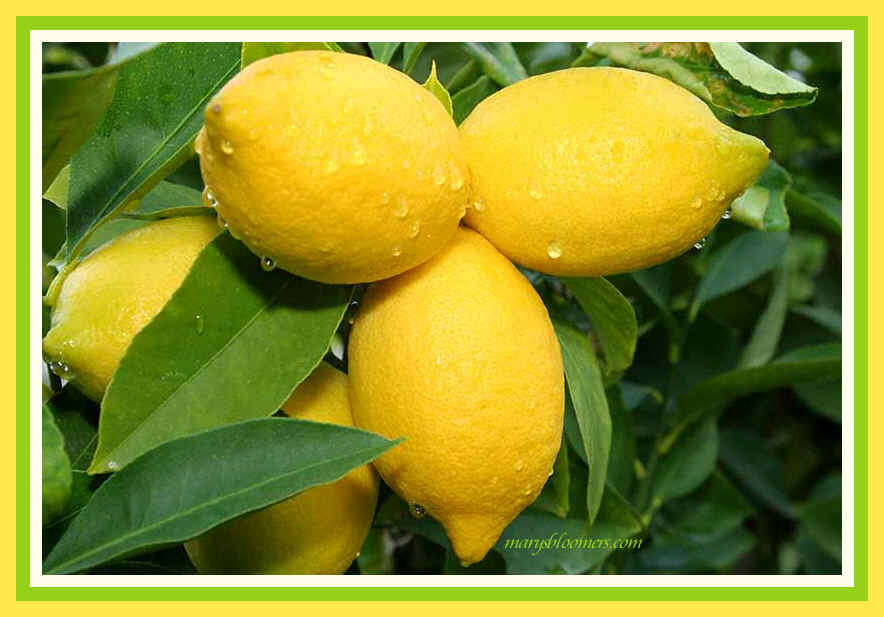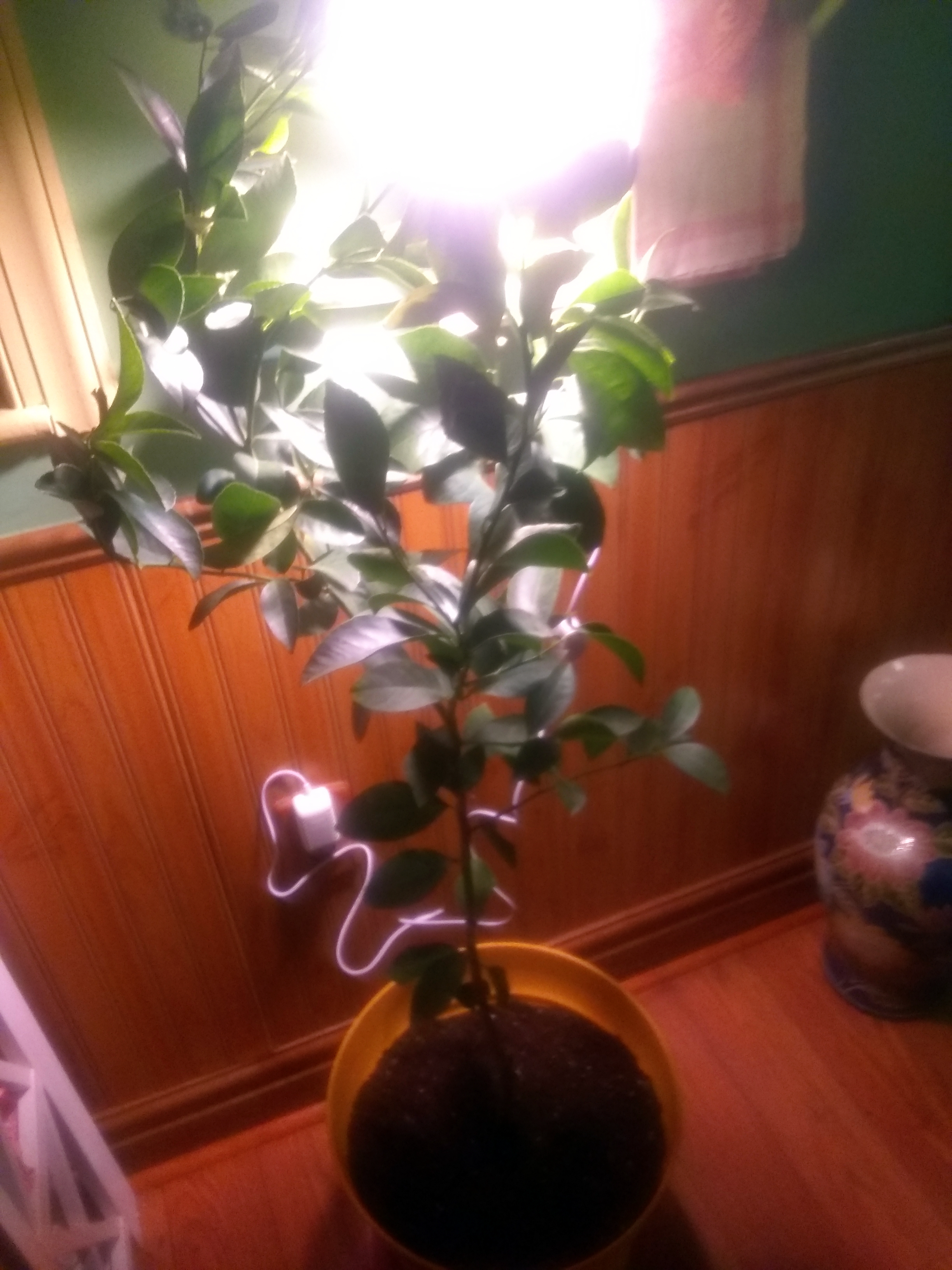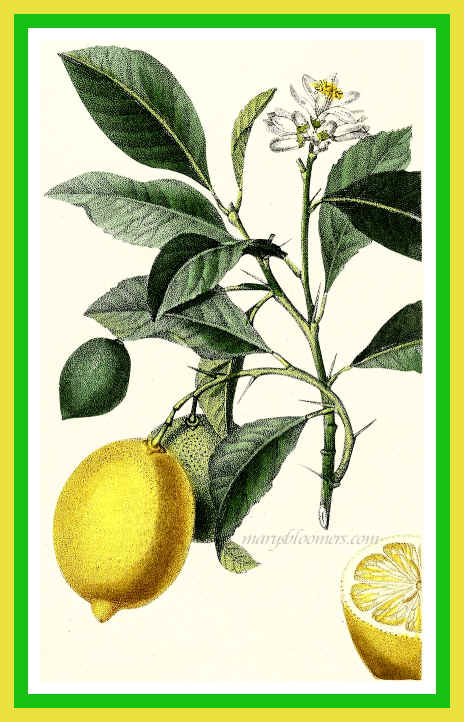 |
||
|
In Zone 6, which is where I am gardening, it's officially winter, and I'm not able to go out and play in the dirt. Too much snow cover to even find the dirt. The gardening and seed catalogs have already begun to take their toll on my psyche with their tantalizing photos and descriptions of plants that i'll have to wait 5 months to see in their outdoor reality. I'll turn on some mood music and ponder growing a couple of fragrant fruit trees that will live on my patio come spring. In my
quest for the simplest of simple for indoor/outdoor container
gardening, I choose dwarf Lemon and Lime trees. Dwarf doen't mean small fruit. Oh no. It means a dwarf fruit tree producing regular-sized fruit. You really can't lose with those.
|
 |
Lemons and limes are what i would like to try first for
moveable patio trees in pots that will live indoors over the
winter. Lime trees seem to be way too tall and too expensive
for my first experiment. So Dwarf Meyer Lemon it shall be.
I use those fruits the most often in winter, and i love the scents of the tree and blossoms. I am picking a couple that are at least a foot tall from my favorite plant nurseries online. I refuse to buy any nursery stock from big box stores and home centers. I buy from the growers. They raise and know their children. And I insist on organic and non-GMO plant stock in my gardens. And in my diet. Meyer lemons are a thin-skinned hybrid fruit, part lemon and part mandarin orange, making them much sweeter than the kind of lemon you’d see at a grocery store. Meyer lemon trees have glossy, dark green leaves and fragrant white blossoms that are purple at the base. When they’re ripe, the skins of Meyer lemons will take on the color of an egg yolk—yellow with a faint orange tinge. Meyer lemon skins are fragrant and a popular ingredient among chefs. The growing is not the challenge, they're easy. Growing them indoors part-time is the challenge. |
|
The tart citrus fruits, like lemons and limes, are easy to grow indoors. Much easier than oranges or grapefruits. I'm good with lemons and limes. I use a lot of them. And considering my space allowances, inside and out, they shall be potted and portable. As a perceived fountain of information on growing big stuff in small spaces, and urban food gardening, i think this will be a fun learning experience. I may even dig up my recipes for lemon-lime ade, preserves, lemon curd and lemon marmalade. The limes i switch for lemons now and then, and use them in Mexican, Thai and Caribbean-style recipes. I use lemon and/or lime juice or leaves in my cocktails and on seafood. I'd rather pick one of these at a time while cooking, than buy the bags. I never seem to use them all before they shrivel and dry up. Meyer Lemons are what I prefer for cooking and baking. They stand up well to sustained cooking and heat, and they're my preferred lemon for lemonade and marmalade. Probably because of that hint of mandarin orange. It also explains why marmalades using the Meyer Lemons and Mandarin Orange taste. Depending on variety, most citrus trees bloom in spring to set fruit that are ready to harvest in fall and winter. Others may flower and fruit off and on year-round. We shall see. If these live, they will be spending their summer vacations outdoors in the beginning of May. |
|
Characteristics
of Meyer Lemon Trees
Perfect for my patio spring and summer, and then I bring them in for winter. Citrus is easily grown in containers in cold climates. The plants can remain outdoors during the growing season but must be brought indoors when temperatures approach freezing. Around Halloween will be when it will be time to bring mine in. Meyer lemon trees can yield fruit in just two years after planting them. Whether you choose to place one on your patio, in your yard, or indoors, the tree is ornamental, fragrant, and a source of sweet and sour vitamin C. -Cross between lemons and mandarin oranges.-Chefs use the sweet and tart skins -Self-pollinating -Will fruit indoors and outdoors -Heavy harvest in winter -Require consistent misting indoors - this is the one thing that might do me in. Citrus leaves crave humidity. If you have an indoor Meyer lemon tree, mist it daily. -It’s also a good idea to place rocks and water in the saucer beneath your big pot, so that humidity will increase..I can't seem remember to mist my plants unless -i leave a misting bottle in the pot with the plant. Watering - These trees need watering only every week or so, and a nice drench each time. Do not water until dry again and don't give it dribbles frequently. A deep watering once a week should do it. If you see leaf curls, time to water. |
||||||||||||
|
About Growing The Dwarf Meyer Lemon Outdoors....
Meyers are usually disease free, but there are three pests that plague it outdoors: scale, aphids and spider mites. Aphids are the easiest to control by washing them off with soapy water and a spray from the hose. For spider mites, look for a houseplant insecticide that is labeled for food crops. Always follow the instructions. Rubbing alcohol works on scale, but you do have to get it early. For natural pesticides that i use in my own garden and indoors, read about it here. Acclimate your lemon tree to the outdoor temperatures and light over a period of several days. Keep it in a sheltered spot, and gradually introduce it to brighter sunshine and the warmer temperatures. Put your indoor tree outdoors when temperatures will be consistently in the 50's. |
||||||||||||
|
Pollination outdoors
shouldn't be a problem. The flowers will definitely attract the bees
and butterflies. I have a pollinator garden
and bird habitat, so a couple of my bases are covered. The birds
eliminate aphids and eat their weight in other pests every day.
Pollination of flowers is taken care of because of the Butterfly and Bee Gardens.
Meyer lemons are
self-fertile so don’t need another tree for pollination. But they
will want pollen spread by pollinators. I'll let
the bees do the pollinating of the single trees. And since Meyer
lemon trees will fruit either indoors or outdoors once or twice a
year, with especially abundant harvests in fall and winter, i'll
consider hand-pollinating if i need to. If your potted Meyer lemon
tree is located outdoors, pollination should take care of itself.
Most lemon trees take 6-9 months to harvest after being successfully
pollinated. That leads me to believe that in my growing zone, with the
large numbers of pollinators, I should have a crop indoors in winter. |
||||||||||||
|
|
||||||||||||
|
-Bearss lime (C. x
latifolia) – also known as Tahitian lime and Persian lime, is a
vigorous, thornless tree that produces bigger fruit than Mexican
limes. This is the lime found most often in grocery stores.
-Kaffir lime (C. hystrix) – is grown for the leaves that are used in Thai and other Southeast Asian cuisine, but it does produce a small, bumpy fruit. -‘Eureka’ lemon – is a thornless cultivar with full-size, striped fruit -‘Meyer’ lemon – a lemon-orange hybrid that produces very juicy, medium-sized, seedless fruits with a very thin skin and sweeter pulp than other types of lemons. |
||||||||||||
| So, let's just
assume you're going to grow a potted dwarf
lemon tree indoors because it's winter, and you're a gardener
fascinated and armed with the indoor fruit tree gardening
details here..... It is best to start with a Meyer lemon tree that is already two to three years old. You can absolutely choose a younger one, but you will have to wait longer for the fruit to appear. Mine will probably be about 1 year old. ***It can take as much as a year after first acquiring a tree before you have fruit large and mature enough for use. Lemons will not ripen once picked, so wait until the fruit is a deep lemon color and slightly soft before you start picking. You must be careful when removing the lemons (don’t yank them off, as you would an apple, as this could damage the tree), so scissors or a sharp knife will make it easier.
|
||||||||||||
-
Plant your Meyer
lemon trees in a big, beautiful pot. I like the styles shown in the |
||||||||||||
|
||||||||||||
|
Making New Plants - Stem cuttings root easily. Use new shoots which have been allowed to harden just a little. Hardened shoots have a little substance to them. Don't use shoots that are still buttery soft.Take cuttings in the spring or
summer when the plants are growing most actively. |
||||||||||||
Pruning a Meyer Lemon Tree
|
||||||||||||
| You should prune your Meyer lemon tree
periodically to maintain its structure and shape, and ensure that its branches
can support fruit. Cut back the branches that do not produce fruit—called long leads—as they grow. The side branches will spread into that space and strengthen so that they can bear the weight of the fruit. Cut any branches that are growing toward the trunk to increase airflow between the branches. Fertilize your plant once every few months. Lemon trees grow well if they get plenty of nitrogen—you can find nitrogen-rich fertilizers at most plant stores. Feed your plant once every 3 weeks in spring or summer and once every 6 weeks in fall and winter. I use organic epsom salts and fish emulsion fertilizers on all plants, indoors and out. We'll see what this adventure brings. Stay tuned. If you're trying this yourself, keep me posted.
Informational
resources: |

